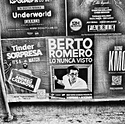John Lockhart
Member
- Joined
- Nov 17, 2009
- Messages
- 42
- Format
- 35mm
I am wondering if other folks have had a similar experience. I have been printing kallitypes, that I gold and platinum tone, for a few months. At first I used Stonehenge Rising. The kind you can get at an art store. Many folks recommend it. However, the results were really mixed. The prints were very often grainy with spotty coverage. One day on a lark I picked up a package of Arches Aquarelle. Again it was nothing special I bought it at a local art supply. It was like night and day. The prints on the Arches were smooth with nice blacks and great highlight detail. They were really beautiful.
After a while I thought I would try a higher end paper. So, I ordered some Lana Aquarelle from Bostick and Sullivan. Its got great body and holds up well in water. However, the prints were not that much better than the Stonehenge. I could tell the second I put the paper in the developer that the Lana was going to disappoint me.
Is there any rhyme or reason why some papers that come highly recommend just fail while others you never considered are wonderful? My process is simple. I just use a foam brush and thats it. The humidity is always the same indoors with air conditioning.
Follow the link below for an example of the same image on two papers. Keep in mind that I was using:
1. The same negative
2. The same developer
3. The same exposure time
4. Same coating procedure
The only difference is that I did put the one on Lana Aquarelle in gold toner for a minute. However, I know that is not a factor since you could see the difference in the prints well before they were toned. The Lana looks similar to what I was getting with Stonehenge.
Dead Link Removed
Any thoughts? I guess it bothers me that the one thing that has made the greatest difference in my printing was a totally random paper selection. Am I not doing some things I could to make the premium papers work better? I really love the way the Lana held up in water and dried flatter, but the end result looked mediocre.
Thanks,
- John
After a while I thought I would try a higher end paper. So, I ordered some Lana Aquarelle from Bostick and Sullivan. Its got great body and holds up well in water. However, the prints were not that much better than the Stonehenge. I could tell the second I put the paper in the developer that the Lana was going to disappoint me.
Is there any rhyme or reason why some papers that come highly recommend just fail while others you never considered are wonderful? My process is simple. I just use a foam brush and thats it. The humidity is always the same indoors with air conditioning.
Follow the link below for an example of the same image on two papers. Keep in mind that I was using:
1. The same negative
2. The same developer
3. The same exposure time
4. Same coating procedure
The only difference is that I did put the one on Lana Aquarelle in gold toner for a minute. However, I know that is not a factor since you could see the difference in the prints well before they were toned. The Lana looks similar to what I was getting with Stonehenge.
Dead Link Removed
Any thoughts? I guess it bothers me that the one thing that has made the greatest difference in my printing was a totally random paper selection. Am I not doing some things I could to make the premium papers work better? I really love the way the Lana held up in water and dried flatter, but the end result looked mediocre.
Thanks,
- John





